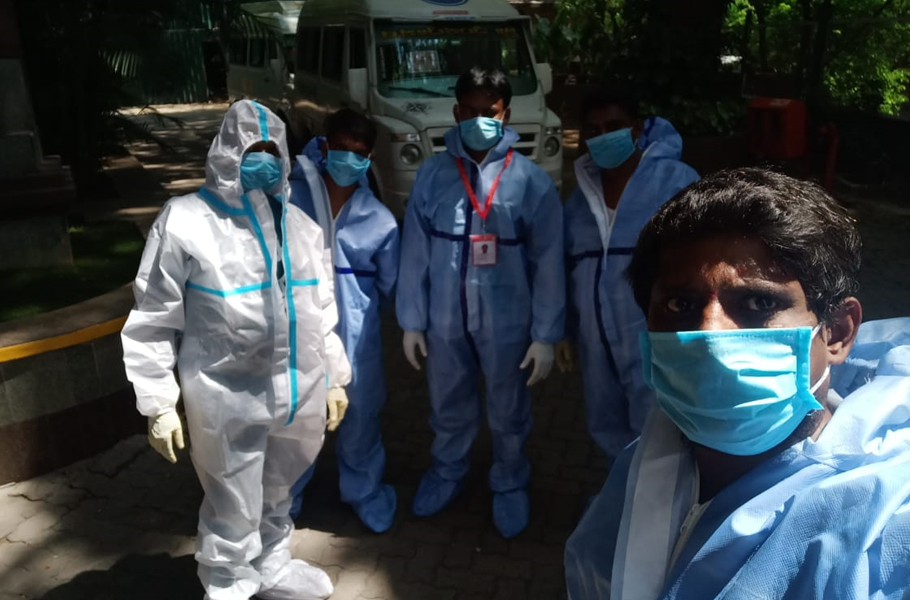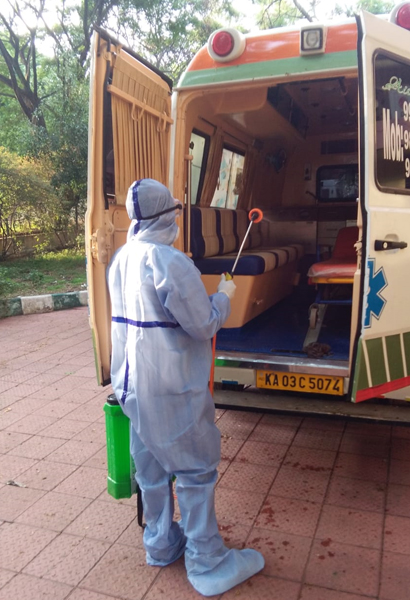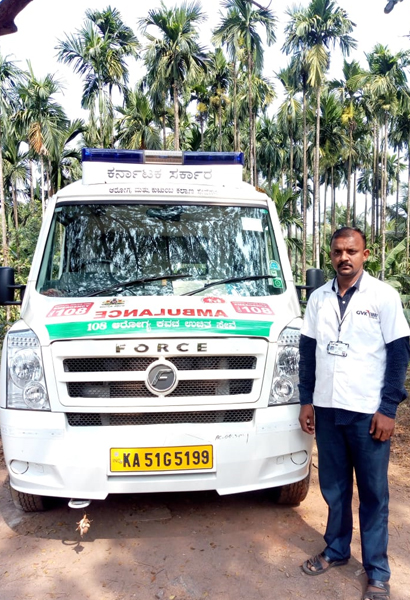
- Home
- News
- Analysis
- States
- Perspective
- Videos
- Education
- Entertainment
- Elections
- World Cup 2023
- Features
- Health
- Business
- Series
- Economy Series
- Earth Day
- Kashmir’s Frozen Turbulence
- India@75
- The legend of Ramjanmabhoomi
- Liberalisation@30
- How to tame a dragon
- Celebrating biodiversity
- Farm Matters
- 50 days of solitude
- Bringing Migrants Home
- Budget 2020
- Jharkhand Votes
- The Federal Investigates
- The Federal Impact
- Vanishing Sand
- Gandhi @ 150
- Andhra Today
- Field report
- Operation Gulmarg
- Pandemic @1 Mn in India
- The Federal Year-End
- The Zero Year
- Premium
- Science
- Brand studio
- Home
- NewsNews
- Analysis
- StatesStates
- PerspectivePerspective
- VideosVideos
- Entertainment
- ElectionsElections
- Sports
- Loading...
Sports - Features
- BusinessBusiness
- Premium
- Loading...
Premium

Behind the wheel of an ambulance: Steering hope amid despair
For ambulance drivers on COVID-19 duty, they have to protect themselves fully and be ready anytime to transport patients to hospitals and back even as they navigate problems and face a high risk of contracting the disease.

Every morning, Danush R, an ambulance driver in Bengaluru city, waits for a call from the health department. His job is to pick up COVID-19 positive patients from their homes or designated hospitals and drop them back after treatment. He is usually assigned a patient who has tested positive and so far, in the last two months, he’s transported about 10 COVID positive patients. Hailing from...
Every morning, Danush R, an ambulance driver in Bengaluru city, waits for a call from the health department. His job is to pick up COVID-19 positive patients from their homes or designated hospitals and drop them back after treatment. He is usually assigned a patient who has tested positive and so far, in the last two months, he’s transported about 10 COVID positive patients.
Hailing from a small village Koppa in Mandya district, the 23-year-old came to Bengaluru hoping to finish high school, but unable to do so, he took up driving and has been driving ambulances for the past three years. And now he is on COVID-19 transportation duty.
For him and fellow ambulance drivers, this is the first time they are witnessing such a crisis where they have to protect themselves fully and be ready anytime.
Despite the risks that come with the job, Danush is content as he says the government took his consent before assigning him to transport COVID-19 patients. “Many rejected (the offer) as they feared they would contract the virus. But I considered it after the government assured us of all the safety kits including the protective gear,” Danush says, though he feels suffocated wearing the overalls all through.
The job comes with its stress, but Danush doesn’t worry. “We see dead bodies on a daily basis. Some on ventilator support die in the ambulances even before reaching hospitals and such cases happen quite often as we push through the city’s traffic and struggle to reach a hospital every day.”
“Except for having nightmares on certain days, we are used to such scenes. The COVID-19 crisis makes it no more difficult, except that we are at high risk of contracting the virus,” Danush says.

Before the COVID-19 lockdown, the city’s traffic stressed him out. During the lockdown, it was like he was the “king of roads” behind the wheels.
“I could transport a pregnant woman, a COVID-19 patient, from one hospital to another, a distance of five kilometres in 10 minutes. That’s something we cannot imagine in the city’s traffic,” Danush says, adding that he is mindful of patients inside while speeding. Now he dreads the lifting of the lockdown completely.
Even as he’s working on the frontline with those infected and their family members, Danush and his fellow ambulance drivers have had to stay away from their families, for fear of putting them at risk.
Danush and another driver have rented a room in the city temporarily, and he interacts with his family over video-calling app.
“We cannot go home and have food with our family members even if they wish to. Though they are encouraging and supportive, we fear for their safety and health,” he adds.
Although he earns ₹20,000-25,000 a month, much of it coming from the people who take the ambulance services, Danush finds happiness in little things like a certificate.
“The government said they will issue us a certificate saying we are ‘corona warriors’. Besides, they also insure our lives just in case something happens to us while at work,” he says.
On a different track
Not all ambulance drivers shared similar experiences. Karnataka has divided the ambulance services into three categories — one for COVID positive patients, another for those under quarantine who need to be taken for testing and the third for non-COVID-19 patients.
Srinivas D, unlike his usual routine of driving an ambulance, now drives a tempo traveller carrying 8-10 people, mostly primary and secondary contacts of the patient, who are to be tested.

While earlier he was responding to 108/102 ambulance helpline calls, Srinivas is now completely on special duty to carry suspected COVID-19 patients.
Soon after he arrives at the hospital gate (CV Raman Hospital in Bengaluru), the first thing he does is to get out of the vehicle and move 10 ft away, remove the PPE he is wearing and take a long breath, giving away all signs of his difficulty in breathing with the PPE on.
With increase in cases by the day and governments testing more people, his workload has also gone up. “So far we haven’t heard any ambulance driver testing positive for COVID-19. That kind of pushes us to keep going with our work daily,” he says.
Soon after the trip ends, he and his helper disinfect the vehicle and keep it ready for the next trip as per the World Health Organisation’s (WHO) guidelines.
Wrong turn
Unlike Srinivas and Danush, there are some ambulance drivers who have crossed the line as they enjoy free movement with little checking.
On April 21, along the national highway 13 in Chitradurga district in Karnataka, an ambulance was parked along the road next to a Maruti van. The police, on getting suspicious, found that the driver was ferrying liquor.
Two days before that, seven people were arrested from an ambulance that ferried people (non-patients) from Puttur to Mysore.
Similarly, in Gurugram, Haryana, a manager of a private hospital and 16 others were arrested for allegedly facilitating transportation of migrant workers in two ambulances amid lockdown.
Problems galore
But such incidents apart, ambulance drivers do face hassles, especially with the lack of proper protective equipment or poor condition of vehicles.
Some ambulance drivers in Hyderabad and Mumbai had alleged that they were working without the required safety gear and that they were not given sanitisers and disinfectant sprays to clean the vehicle.
Some ambulance drivers in different cities have reported being tested for COVID-19. Two drivers who drove five patients who were institutional quarantine, travelled 3,000 km from Chennai to Tripura. While they were screened before leaving the city and showed no signs of COVID-19 upon arrival, one of them has recently tested positive. This became a burden to health officials as they had to trace their contact history throughout the journey.

A few who work for the private ambulance initiative led by GVK EMRI, a non-profit organisation that operates ambulances on a public-private partnership (PPP) model in almost 16 states, alleged that the company has threatened to terminate them if they complain about work or vehicle conditions.
A road better not travelled
Suryakanth S Jevalagi, an ambulance driver in rural areas of Udupi district, says he initially drove in Kalburgi in north Karnataka where he hails from, but was transferred with a promise that he would be taken back.
Even after two years, he’s posted in a different district and he earns half of what the urban ambulance driver earns. Besides, now he has to spend extra for renting a place as he stays away from his family.
A contract employee, Jevalagi says even though he’s supposed to get ₹100 for every extra hour of work, he barely gets 1/10th of it at the end of the month.
Besides, he says, his complaints about poor quality masks and gloves, lack of PPEs, and need to replace vehicles tyres have fallen to dear ears.
“Even after driving for 54,000 km and requesting four times to change the tyres, they haven’t done it. They ask us to drive up to 90,000 km. How is that possible with the current road conditions?” he asks.
His only respite is tech-savviness as he puts out videos on Tik Tok and Facebook about safety measures that citizens should adopt, besides educating them about how to call an ambulance in case of an emergency.
Jevalagi recalls an incident where he could not reach the hospital on time due to the poor condition of the vehicle. But then, he and the paramedic staff managed to park the vehicle on the roadside and helped a woman patient deliver a baby in the ambulance. “Both the woman and baby were safe and we took her to the hospital soon after delivery,” he says happily.
“If we complain, they ask us to quit the job. As there are many drivers waiting to get jobs, they will hire someone inexperienced at a lower cost,” he says.
Jevalagi, who has two children, whom he wishes to see as doctors one day, says he cannot support his family with the money he earns. Besides his wife and two children, he also has to support his ailing father.
“We keep our lives in hand all time and drive the patients safely to hospitals. But it’s sad that we are not cared for even in times of crisis like this,” he says in frustration.
The pride that he felt about serving in times of crisis like this has waned, and Jevalagi wants to put an end to this job, considering that there are no increments or appreciation, and wishes to take up farming in his village where he has three acres of land.
“All we need is two pair of good dresses and a plate full of food to eat. If we have to struggle for this even as we see through pain every day, we’d better look for alternatives,” Jevalagi says.
(This story is part of a series on frontline personnel in the fight against COVID-19. You can read the other stories here)

